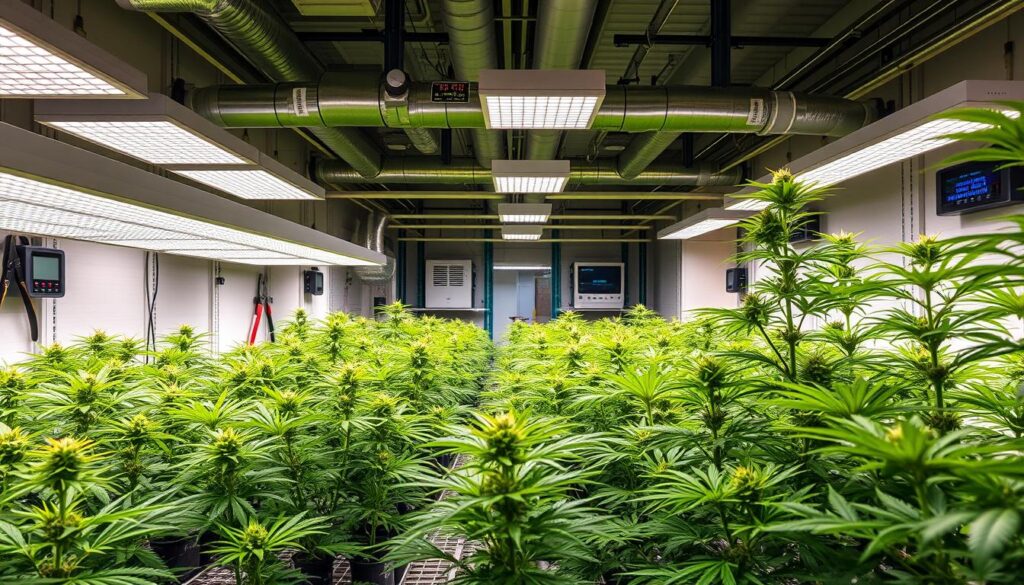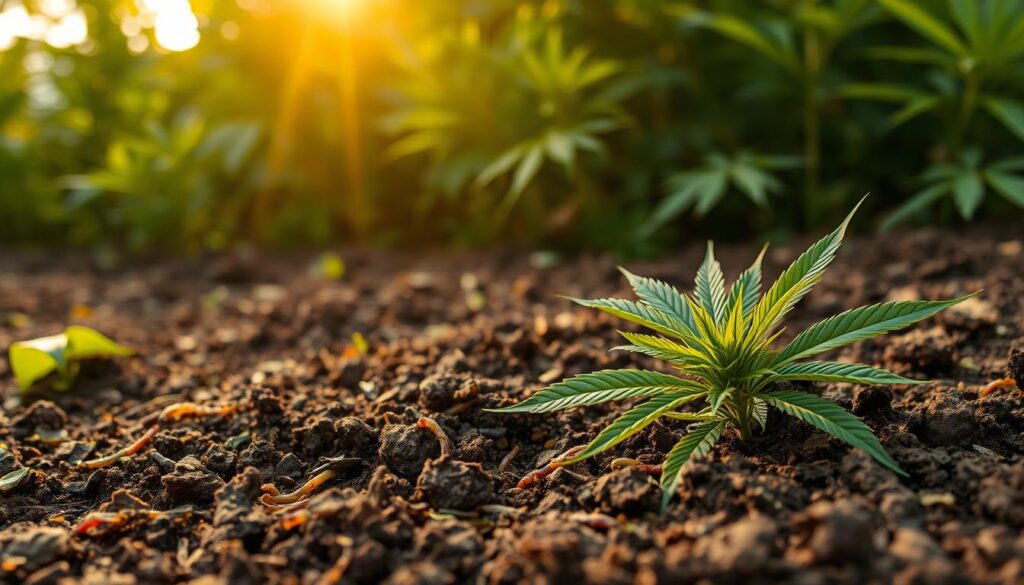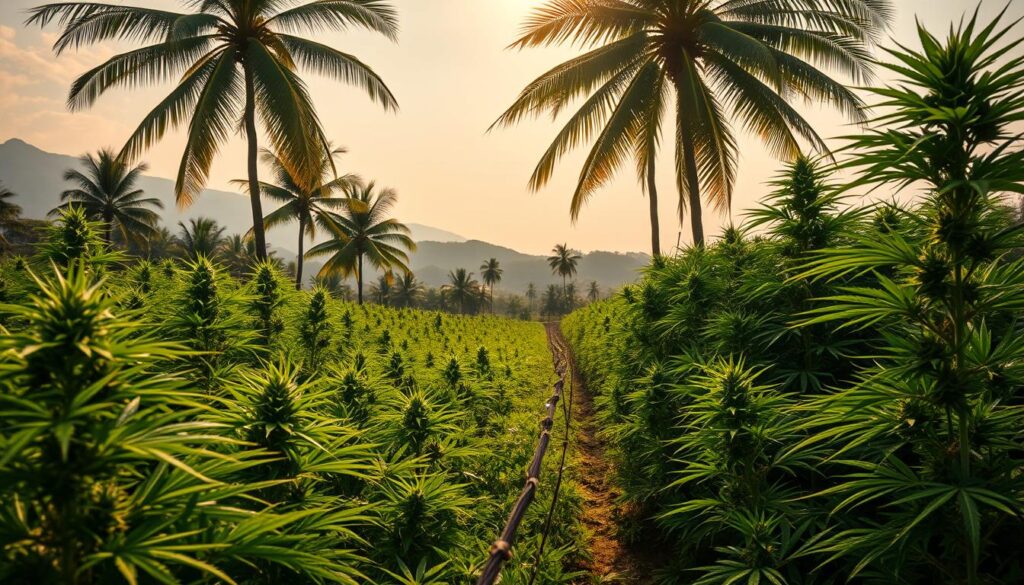Welcome to your essential guide for growing cannabis in Thailand’s beautiful coastal region. This guide is for both new and experienced gardeners. It will help you navigate the local climate, legal rules, and growing techniques in this area.
Hua Hin’s warm weather and rich soil are perfect for growing plants. Let’s see how these conditions help plants thrive.
First, it’s important to know about Thailand’s changing laws on growing plants. Always check the latest laws to follow them. This guide focuses on safe growing and shows how to maximise yields with special growing tips.
Key Takeaways
- Hua Hin’s coastal climate offers year-round warmth and humidity suited for cannabis growth
- Thai law permits personal cultivation with strict licensing requirements
- Local soil amendments boost plant health in sandy coastal terrain
- Microclimates vary significantly between beachfront and inland zones
- Community-supported agriculture initiatives provide shared resources
You’ll learn useful tips for every step, from picking strong strains to harvesting. We’ll also show how local growers use green methods that care for Hua Hin’s nature.
The Legal Landscape of Cannabis in Hua Hin District
Understanding Thailand’s cannabis laws can be tricky. But, here’s what you need to know for Hua Hin. Since 2022, the country has made big changes. Now, local rules balance access with safety.
Whether you grow for yourself or to sell, knowing the rules is key. There are three main things to understand.
Understanding Local Regulations
Hua Hin has its own rules, based on Thailand’s laws. You can grow up to 15 cannabis plants per household for personal use. But, they must not be seen from outside.
The district has strict rules about where you can grow:
- No outdoor grows within 300 metres of schools
- Commercial operations restricted to agricultural zones
- Absolute ban near temples or royal properties
Licensing Requirements
Want to sell your cannabis? You’ll need a licence. Here are the types:
| Licence Type | Eligibility | Cost (THB) | Processing Time |
|---|---|---|---|
| Personal Cultivation | Thai nationals only | Free | 7 days |
| Commercial Production | Registered business | 25,000 | 45-60 days |
| Medical Cannabis | Approved clinics | 50,000 | 90 days |
Health and Safety Standards
Hua Hin cares about the quality of cannabis. Commercial growers must:
- Install 24/7 security cameras
- Submit monthly lab tests for THC levels
- Use child-resistant packaging
For health reasons, getting a medical cannabis prescription is safest. Remember, throwing away cannabis waste can cost up to 100,000 THB. If unsure, call Hua Hin’s Cannabis Compliance Office. They are very helpful!
Choosing the Right Strain for Your Needs
Finding the right cannabis strain in Hua Hin is more than just a choice. It’s about working with nature. The tropical climate here offers special chances, but you must match the plant to your garden. We’ll look at how to pick wisely, balancing growth and the effects you want.
Popular Strains in Hua Hin
Local growers love these easy-to-grow varieties:
- Thai Stick (Sativa): Loves the humidity and takes 10-12 weeks to flower. It gives a lively buzz and tastes like citrus.
- Durban Poison (Sativa-dominant): Does well with changing temperatures, making dense buds with earthy tastes.
- Northern Lights (Indica): Perfect for small spaces, grows fast and relaxes you in 8 weeks.
For those wanting new hybrids, 5 strains to try in Thailand’s growing cannabis scene are great for Hua Hin’s coast.
Considerations for Growth Conditions
Three main things decide if a strain will grow well:
- Humidity resilience: Choose strains that resist mould in the rainy season
- Sunlight needs: Sativas need more sunlight than indicas
- Soil drainage: Use quick-draining soil to avoid root rot in wet times
Even tough strains need watching. Coastal areas have big temperature changes that can stress plants. Start small before growing a lot.
Preparing Your Grow Space
Choosing between balcony and indoor setups in Hua Hin affects your grow journey. You might have little space or want to grow all year. Creating a good environment is key for healthy plants and good yields. We’ll look at how to make the most of Hua Hin’s climate.

Balcony Cultivation vs Dedicated Indoor Setups
Balcony grows get natural light and air, great for Hua Hin’s weather. But, unpredictable rain and limited privacy can harm plants. Indoor setups let you control everything but cost more upfront. Think about these points:
| Factor | Balcony | Indoor |
|---|---|---|
| Sunlight Access | Free, natural light | LED/grow lights needed |
| Space Efficiency | Limited by railing height | Vertical grow tents possible |
| Startup Cost | Low | ฿15,000–฿30,000+ |
| Pest Control | More vulnerable | Easier to manage |
Pro tip: Many Hua Hin growers start on balconies in dry seasons (November–April). Then, they move indoors for the monsoon.
Must-Have Tools for Hua Hin Growers
Local shops now have all you need, from basic to pro gear. Don’t forget these must-haves:
- pH testers (฿450–฿1,200) – Check soil acidity at places like Green Leaf Hua Hin
- Fabric pots – Better drainage than plastic
- Oscillating fans – Keep indoor humidity down
- Organic pesticides – Neem oil blends at Chat Chai Market
For bigger grows, grow tents (฿6,500+) and carbon filters are key. Make sure to check equipment is certified. Look for CE marks or Thai FDA approvals when buying in Hua Hin.
Soil and Nutrients: Building an Optimal Environment
Creating the perfect foundation for cannabis growth starts with understanding your soil’s unique character. In Hua Hin, the native earth often contains a mix of sandy loam and clay – great for structure but needing tweaks for drainage. Let’s dig into how to transform local dirt into a thriving ecosystem for your plants.

Soil Types Best Suited for Cannabis
Hua Hin’s coastal soil leans towards alkaline pH levels (7.2-7.8), which cannabis generally dislikes. You’ll want to:
- Mix in peat moss or coco coir to lower pH to 6.0-6.5
- Add perlite (30% ratio) for better aeration
- Layer composted coconut husks – abundant locally – for water retention
Many successful growers blend three parts native soil with one part commercial potting mix. This approach maintains local mineral content while improving drainage – crucial during Thailand’s monsoon season.
Nutrient Options and Their Benefits
Cannabis hungers for specific nutrients at different stages. During vegetation, focus on nitrogen-rich formulas. Flowering calls for higher phosphorus. Top options available at marijuana dispensaries Hua Hin include:
| Product Type | Key Benefit | Best For |
|---|---|---|
| Fish emulsion | Quick nitrogen boost | Early growth |
| Bat guano | Slow-release phosphorus | Bud development |
| Seaweed extract | Micronutrient cocktail | Entire lifecycle |
Local dispensaries now stock monsoon-season blends with added magnesium to combat heavy rain’s leaching effects. Ask about organic mycorrhizal additives – they help roots absorb nutrients 40% more efficiently in Hua Hin’s climate.
Cultivation Techniques for a Successful Yield
Learning to grow cannabis in Hua Hin is exciting. You need to get used to the coastal weather. There are simple ways to grow lots of plants, even on a small balcony. These methods help your plants grow well and support cannabis tourism in the area.
Germination Methods
Begin by learning how to get seeds to grow. The paper towel method works well, with a success rate of 85-90%. Just put seeds in a damp paper towel and keep it dark.
For those near the sea, try planting seeds directly in the soil. Mix local sandy loam with coconut coir. This keeps the soil moist but stops it from getting too wet.
| Method | Success Rate | Time to Sprout | Best For |
|---|---|---|---|
| Paper Towel | 85-90% | 2-4 days | Controlled environments |
| Direct Soil | 70-80% | 5-7 days | Coastal gardens |
| Starter Cubes | 80-85% | 3-5 days | Workshop demonstrations |
Pruning and Training Your Plants
Low-stress training (LST) is great for small spaces in Hua Hin. Gently bend stems to make flat canopies. This lets more light reach the plants.
“We teach tourists to shape plants like bonsai trees – it’s gardening meets art,“
explains a local instructor. Use LST and remove some leaves to improve air flow. This is very important in humid weather.
Pest Management Strategies
Use natural ways to fight pests:
- Neem oil sprays (apply at dusk)
- Companion planting with marigolds
- Garlic-chilli water deterrent
Growers near the sea should use salt-tolerant plants. Rinse leaves after sea winds. Many cannabis tourism activities now teach how to prevent pests. It’s a great way for visitors to learn.
Harvesting and Storing Your Cannabis
Getting the final steps right is key to great results. In Hua Hin District, timing and skill make a big difference. Growers near the coast face special challenges like salt air and humidity.
Identifying the Right Time to Harvest
Use a jeweller’s loupe to check trichomes. Look for 70% milky-white and 30% amber for the best effects. When pistils turn rusty orange and leaves start to yellow, it’s time to pick.
Coastal growers should pick 2-3 days before those inland. This helps avoid damage from salt.
Best Practices for Drying and Curing
In Hua Hin, old Thai ways meet new needs. Dry buds in dark, well-ventilated places at 18-21°C with 50% humidity. Use terracotta pots with unbleached coffee filters for curing.
Rotate buds every day. Add dried lavender to keep humidity in check. This trick comes from local weed culture.
Ensuring Proper Storage Conditions
Keep terpenes fresh by storing in mason jars in dark pantries for 6-12 months. For longer storage, use vacuum-sealed bags in wine coolers at 16°C for up to 18 months.
For balcony storage, try beeswax wraps for 2-3 weeks. Add cedar wood chips to jars for natural protection. This fits Hua Hin’s love for handmade quality. weed in Hua Hin District . weed in Hua Hin District . weed in Hua Hin District . weed in Hua Hin District . weed in Hua Hin District .

